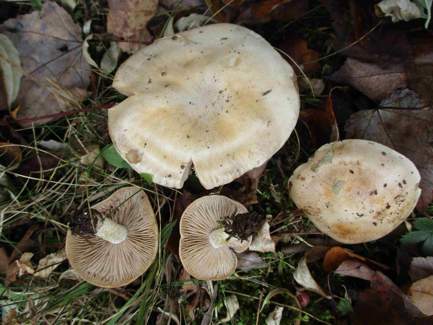 Hebeloma sporadicum (Photo: D. Wasilewski)
Hebeloma sporadicum (Photo: D. Wasilewski)Taxonomy
Full name: Hebeloma sporadicum A.H. Sm., Mycologia 30 (1): 34 (1938)Genus: Hebeloma
Section: Denudata
Subsection: Crustuliniformia
Types: UNITED STATES: Michigan: Saginaw Forest, Ann Arbor (approx. 42.27°N, 83.8°W, alt. approx. 280 m a.s.l.) under Picea sp., 7 Oct. 1936, A.H. Smith (55050) (Holotype. herbarium acc. no. MICH 10811, HJB1000033; Isotype. herbarium acc. no. K(M)139708, HJB1000046).
- arrow_drop_downarrow_drop_upEtymology
- arrow_drop_downarrow_drop_upOriginal diagnosisPileus convexus, demum planus, viscidus vel glutinosus, glabrus, sordide albidus vel pallide ochraceus, margine involtus et saepe maculatus; caro albida, firma inodora; lamellae confertae, latae, adnexae, gutulatae; stipes 4-8 (10) cm. longus, 1-2 cm. crassus, solidus, albidus, apice guttulatus, subglabrus; sporae 9-12 x 5-6.5 μ; cheilocystidia 50-70 x 8-10 μ.
- arrow_drop_downarrow_drop_upEnglish translationPileus convex, then applanate, viscid or glutinous, glabrous, dingy whitish or pale ochraceous, with involute and often stained margin; context whitish, firm without smell; lamellae crowded, broad, adnexed, beaded; stipe 4-8 (10) cm long, 1-2 cm thick, solid, white, beaded at the apex, subglabrous; spores 9-12 x 5-6.5 μ; cheilocystidia 50-70 x 8-10 μ.
References
Description
- arrow_drop_downarrow_drop_upThresholds
Description of Hebeloma sporadicum based on 10 collections
- arrow_drop_downarrow_drop_upMacroscopic descriptionPileus: (28) 31–98 (130) mm diameter; shape occasionally convex, applanate or broadly umbonate, rarely strongly umbonate; characters occasionally spotting, rarely remains of universal veil; margin characters often involute, occasionally smooth, rarely reflexed or wavy; viscosity tacky when moist; colour variation often unicolour, occasionally two color; colour at centre often cream, occasionally pale cream, rarely pinkish buff or cinnamon.
Lamellae: attachment often emarginate, occasionally adnexed; maximum depth 3–12 mm; number of complete lamellae 80–108; presence of tears often visible with naked eye, occasionally visible with x10 lens; white fimbriate edge often present, occasionally weak.
Cortina presence: no.
Stipe: (31) 37–79 (100) x (7) 8–15 (20) {median} x (7) 8–19 (20) {basal} mm; stipe Q 4.0–5.0; base shape often cylindrical, occasionally clavate; floccosity often floccose or pruinose at apex; rooting no; thick rhizoids at base absent;
Context: Texture firm; stipe interior often hollow or stuffed; stipe flesh discolouring usually no, rarely yes; slenderness measure 3.2–7.1; smell often odourless, occasionally raphanoid or weakly raphanoid; taste often weakly bitter or none where recorded.
Spore deposit colour: brownish olive.
Exsiccata characters: Not recorded.
- arrow_drop_downarrow_drop_upMicroscopic descriptionSpores: shape amygdaloid, occasionally limoniform; colour in microscope often yellow brown, occasionally brown yellow or yellow; guttules yes. papilla variable occasionally weak; Spore Code: O3 O4; P1 P2 (P3); (D0) D1.
Basidia: (20) 22–37 x 7–11 (12) μm; ave. Q 2.0–3.8; spore arrangement 4 spored;
Cheilocystidia: main shape clavate-stipitate, occasionally capitate-stipitate, rarely clavate-lageniform or clavate-ventricose or spathulate-stipitate; special features observed occasionally apical thickening or sinuate, rarely conglutinate, many collapsed in exsiccata or septa; cheilocystidia ratios: A/M = 1.81–2.68; A/B = 1.76–3.10; B/M = 0.87–1.09.
Pleurocystidia: none seen.
Ixocutis: epicutis thickness (measured from exsiccata) up to 110 μm; ixocutis hyphae width up to 7 μm; ixocutis hyphae encrustation yes; shape of trama elements beneath subcutis cylindrical up to 17 μm wide.
Caulocystidia: Similar to cheilocystidia but larger, up to 90 μm.
- arrow_drop_downarrow_drop_upSpore measurements
- arrow_drop_downarrow_drop_upCheilocystidia measurements
- arrow_drop_downarrow_drop_upHabitat and distributionHebeloma sporadicum's preferred habitat appears to be sloping lawn or mixed woodland with grassy soil or soil and litter. Where only one possible associate was recorded, the most commonly recorded associate was Carpinus (50.0%) but Picea (33.3%) and Quercus (16.7%) were also recorded. In these cases the most commonly recorded families were Betulaceae (50.0%), Pinaceae (33.3%) and Fagaceae (16.7%). We have additional records where Fagus (22.2%), Pinus (22.2%) and Populus (11.1%) were recorded as possible associates, but in these cases a number of possible associates were mentioned. Overall the most commonly recorded families are Pinaceae (44.4%), Fagaceae (44.4%), Betulaceae (33.3%) and Salicaceae (11.1%) The growth habit of our collections was occasionally gregarious or scattered and rarely caespitose or solitary.
According to our current collections, the species is found only in Northern America. On the continent, collections have been found only in the temperate broadleaf & mixed forests WWF biome The World Wildlife Fund (WWF) have divided the world into 867 terrestrial ecoregions. The ecoregion here is estimated by mapping from the GPS coordinates of the collection using data made available by Dinerstein et al (2017). Use this webtool to explore the ecoregions visually or see a full list of current ecoregions on Wikipedia. (Appalachian-Blue Ridge forests (60.0%) and Southern Great Lakes forests (30.0%) ecoregions). From collector information, it appears collections have been found in the 14.5 Urban Areas (60.0%) and 1.4 Forest – Temperate (40.0%) IUCN habitats We map from the collector's description of the habitat to the International Union for Conservation of Nature (IUCN)'s definition using a standardised set of rules. Please see this page for a full list of IUCN habitats.. Within Northern America we have records from Northeastern U.S.A. (Pennsylvania, New Jersey, Michigan and New York) and Eastern Canada (Ontario).
Geographic distribution
Phenology
- arrow_drop_downarrow_drop_upAdditional cited collections